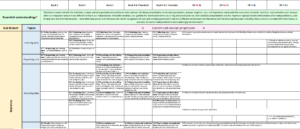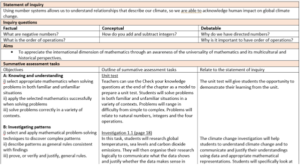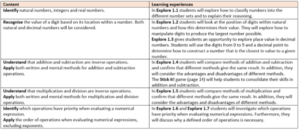
In her first article, Paula Rowlands outlined how a smooth transition between the MYP and DP is supported by having a seamless continuity of mathematics concepts, fostering a sense of curiosity and inquiry throughout the MYP, developing problem-solving, a consistent development of ATL skills, and the integration of the graphic display calculator as a learning aid prior to starting the DP course.
In this second article, Paula discusses the continuity of mathematical concepts and demonstrates how the Pearson Mathematics for Middle Years Programme series can support teachers when planning the written curriculum.
1. Supporting the progression of mathematics concepts within the written curriculum
Schools that follow a national curriculum such as the US Common Core (NGA Centre) or the National Curriculum (UK Government) have clear guidance on the content to be covered at each stage of students’ educational development. Although the content is specified, schools still have autonomy over the skills progression and the resources that can be used. This can result in teachers relying on a scope and sequence as outlined by a published scheme, or relying on a mix of other disjointed resources, the merits of which are discussed by Foster et al (Foster).
The MYP framework specifies its guidance to align with the aims and objectives of the programme and gives a broad reference to topics (IB MYP). Teachers are free to collaborate and develop units of study to suit the needs of their school, but care must be taken to ensure content is presented at a suitable stage; consideration must be given to the students’ cognitive development stage and to how the material is presented. Some MYP schools base their whole-school continuum on the research of other national systems, sometimes choosing the one that fits their philosophy, their host country’s or a combination of sections from different ones. In some cases, the end point of the reference curriculum at age 16 may not be the starting point for the DP curriculum.
The new Pearson MYP Maths series provides an additional point of reference for teachers: it considers the sequence progression of mathematics topics within the MYP framework with the specific intention of meeting both the aims of the MYP and supporting the preparation of students for the DP course. The Teacher Guides that form part of the series provide a mapping document which outlines topic progression through the MYP branches (IB MYP): number and abstract reasoning, thinking with models, spatial reasoning, and reasoning with data. Each branch is further divided into sub-branches and topics, identifying how the concepts are developed from book to book and how it leads to content for each of the four DP courses, Figure 1 below.

Download an extract from the mapping document
The content within the textbook chapters is written and edited by experienced mathematics teachers, examiners and resource developers, in line with current pedagogical research (Boaler). The mapping diagram is intended for use as a tool to view the content progressions through the textbook series, facilitating their use as classroom resources that can be tailored to fit any school’s circumstances. As the MYP school community is often transient in nature – students frequently arrive from different countries having followed different curricula – the flexibility of the Pearson series, and the structure of the mapping diagram, also supports students and teachers with identifying potential content discontinuity.
2. Supporting the development of unit planning for the written curriculum
Content progression through the Pearson Mathematics for Middle Years Programme series is demonstrated in the mapping diagram. However, when and how the content is delivered within the classroom can be decided upon by individual schools. Each chapter contains Explore, Investigation and Practice tasks and these can be combined into MYP units in line with individual schools’ requirements.
This textbook series provides the flexibility for collaborative unit planning and design within individual schools. The Teacher Guides contain detailed unit plans for the chapters outlining how the topics can be covered, the resources available, the suggested global context, and key and related concepts that are explored through the content. An example of how the unit is established is shown below.

See Figure 2 as a larger image
The MYP framework relies upon teachers collaboratively designing units of study that incorporate the content within the global context and the key concepts of form, logic and relationships. Suggestions are given in the unit plans for these and for a statement of inquiry, inquiry questions and possible criterion assessments, including how they relate to the statement of inquiry, Figure 3.

See Figure 3 as a larger image
The content that is contained within the unit chapter is summarised and associated learning experiences are outlined to help guide the delivery of the unit, Figure 4.

See Figure 4 as a larger image
The Teacher Guides that accompany the new Pearson MYP Maths series are designed to support the individual curricula that each MYP school implements in accordance with its own needs and philosophy. The mapping document and the unit plans are suggestions, and it is hoped that they can be used as a place to either start the process of unit planning, or to provide additional support for those teachers who have plans in place but would like to focus more on developing their classroom activities.
In my next blog post, I will explore how this series is a great resource to help develop inquiry-based learning, to develop students’ problem-solving skills and provide as smooth a transition from MYP to DP as possible.
You can download a free unit plan from the Pearson Mathematics for Middle Years Programme Year 1 Teacher Guide now.
Works cited
Boaler, Jo. Limitless Mind, Learn, and Live Without Barriers. HarperOne, 2019.
Mathematical Mindsets: Unleashing Students’ Potential through Creative Math. Wiley, 2016.
Foster, C., Francome, T., Hewitt, D & Shore, C. “Principles for the design of a fully-resourced, coherent, research-informed school mathematics curriculum.” Journal of curriculum studies DOI:10.1080/00220272.2021.1902569 (2021).
IB MYP. “Middle Years Program – Mathematics Guide 2020.” 2020.
NGA Centre. n.d. <http://www.corestandards.org/Math/>.
Pearson. IB Middle Years Mathematics Series. Pearson, 2021.
UK Government. n.d. September 2021
Sign up to receive our blog updates
Like what you read and want to receive more articles like this direct to your inbox? Subscribe to our blog and we’ll send you a fortnightly digest of the blog posts you may have missed, plus links to free resources to support your teaching and learning.

